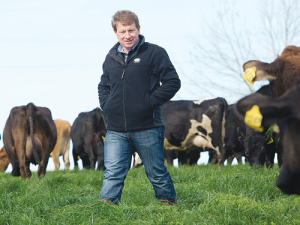Fonterra slashes forecast milk price, again
Fonterra has slashed another 50c off its milk price forecast as global milk flows shows no sign of easing.
 Fonterra’s John Wilson says despite high fat prices it is currently more profitable for Fonterra to make milk powder than butter.
Fonterra’s John Wilson says despite high fat prices it is currently more profitable for Fonterra to make milk powder than butter.
Despite high fat prices it is now more profitable for Fonterra to make whole milk powder than butter and skim milk powder, co-op chairman John Wilson says.
“Skim prices are low and fat prices are high,” Wilson told the Jersey NZ conference.
“When companies are thinking about how they optimise their product mix to maximise their returns they are thinking not only about that fat component.
“They are thinking about that other bucket of milk – the value of the bucket of milk in Europe, for example. During the recent past, skim and butter have not been the most efficient product mix. The most efficient product mix has been cheese.”
Wilson says European manufacturers have been more inclined to use their marginal milk to produce cheese rather than skim and butter even though butter prices are high.
“That is creating a shortage of butter and fat products.
“In New Zealand now it is far more profitable for us to produce whole milk powder than the skim and butter mix.
“We will produce butter for our own businesses and key customers if the price mechanism is right, but in general with marginal milk that is not the preferred product mix.”
This changes regularly and three months ago it was different, he says.
“That gives you some perspective on whether it is purely demand-driven or partly because of the ratio today between skim versus butter.”
Wilson says pleasingly, although a little bit belatedly, the European Commission is now selling skim intervention stock into the market.
“They are taking quite a significant loss on it but there has been about 50,000 tonne [sold] over the last three or four weeks after a peak of about 387,000 tonnes. So we are starting to see some of that skim sold out of intervention.
“What they do over the next 12 months will be very interesting although they have said they are not taking any more product into intervention.”
NZ Fonterra skim is now selling for about $200 - $400/tonne more.
Wilson says the value component ratio is one of the ways Fonterra reflects the value of the different milk coming off NZ farms.
“We do it through a number of different mechanisms. We reflect transparently the cost of processing peak milk, the cost of processing low solids versus high solids milk and the value in the marketplace of fat and protein.”
Farmer interest continues to grow as a Massey University research project to determine the benefits or otherwise of the self-shedding Wiltshire sheep is underway. The project is five years in and has two more years to go. It was done mainly in the light of low wool prices and the cost of shearing. Peter Burke recently went along to the annual field day held Massey's Riverside farm in the Wairarapa.
Applications are now open for the 2026 NZI Rural Women Business Awards, set to be held at Parliament on 23 July.
Ravensdown has announced a collaboration with Kiwi icon, Footrot Flats in an effort to bring humour, heart, and connection to the forefront of the farming sector.
Forest & Bird's Kiwi Conservation Club is inviting New Zealanders of all ages to embrace the outdoors with its Summer Adventure Challenges.
Grace Su, a recent optometry graduate from the University of Auckland, is moving to Tauranga to start work in a practice where she worked while participating in the university's Rural Health Interprofessional Programme (RHIP).
Two farmers and two farming companies were recently convicted and fined a total of $108,000 for environmental offending.

OPINION: The release of the Natural Environment Bill and Planning Bill to replace the Resource Management Act is a red-letter day…
OPINION: Federated Farmers has launched a new campaign, swapping ‘The Twelve Days of Christmas’ for ‘The Twelve Pests of Christmas’ to…